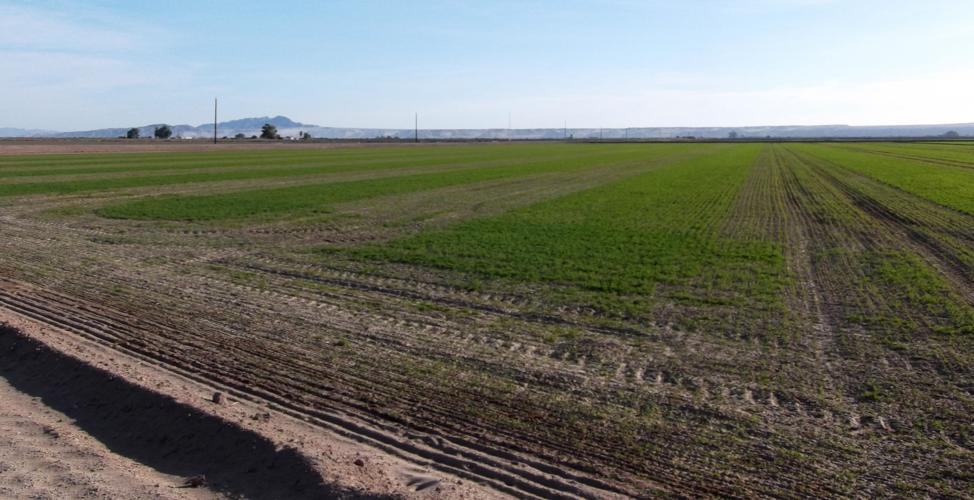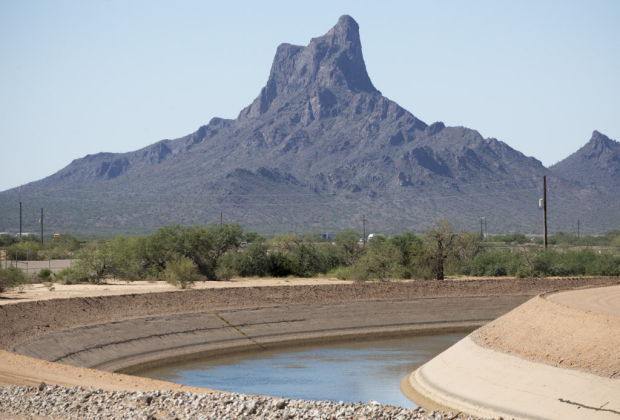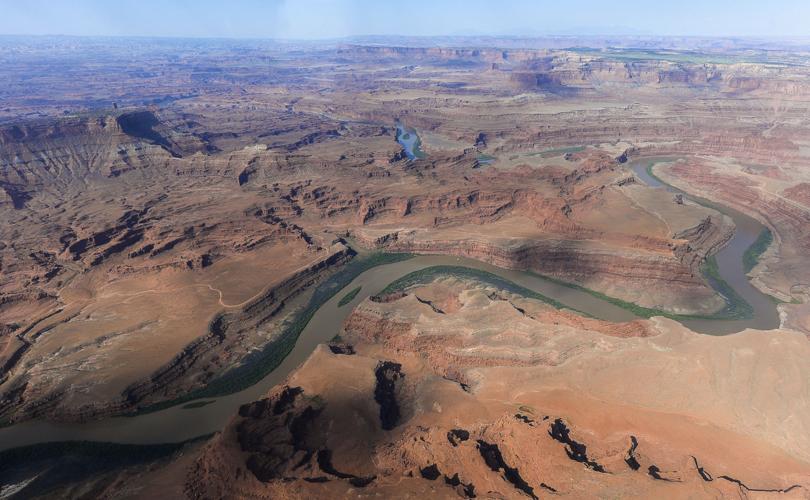Think of it as a water bailout, easing Arizona’s Colorado River woes and the legal-environmental water conflicts plaguing many rural communities.

Alfalfa fields on Colorado River Indian Tribes land near Parker, Arizona.
Think of it as a boon for Indian tribes looking to make better and more lucrative use of their river water.
Or, think of it as an enabler of growth and sprawl from Sierra Vista to Prescott and points beyond.
All these descriptions could apply to a complex plan to send tribal water from the Colorado River into Arizona’s heartland to support existing residents and future development.
Four Indian tribes owning the biggest and the most shortage-proof share of Colorado River water in the Lower Basin want to spread that booty around Arizona. They’re offering a “drought supply,” backstopping existing supplies now threatened by growth and climate change.
The Colorado River Indian Tribes, commonly called CRIT, want to lease more river water than is delivered each year to the city of Tucson to various water agencies, utilities and the feds. For that, they want more money than they now make from their alfalfa fields, where the water currently goes.
For more than a year into late 2016, the tribes, working with the Phoenix-based Salt River Project, held secret discussions about a possible leasing arrangement with officials of the state’s most powerful water agencies, the federal government and the Governor’s Office. The Star learned of the talks through public records obtained from one of the agencies, the Central Arizona Project.
The negotiations are now on hold, partly because of a separate power struggle between the CAP and the Arizona Department of Water Resources that’s kept their leaders from speaking to one another. But many observers expect these talks to resume sooner or later, and the tribes continue to push for the leasing. A couple of issues related to this deal are already slated for discussion by a Colorado River working group representing various water interests that was appointed by Gov. Doug Ducey.

Headgate Rock Dam near Parker diverts Colorado River water onto Colorado River Indian Tribes farmland. The Colorado River and Lake Moovalya are in the background, with the main canal in the foreground.
State and CAP officials have said this is a potentially worthwhile solution but that many legal, financial, technical and political issues need to be resolved. First, the tribes would need federal legislation to allow them to even lease their water off the reservation.
Robin Silver, an environmentalist, is wary, raising concerns that the leasing plan could foment urban sprawl. Kathleen Ferris, a former state water official, raised major concerns about the secret talks, although she doesn’t oppose the proposal outright.
For now, “There are not any deals for water to be leased from CRIT. There are not even any negotiations,” said Margaret Vick, the tribes’ attorney, in an email. “What the tribes have discussed are options to illustrate to the water users in the state of Arizona the many possibilities from a possible new supply. ... We are still in the process of evaluating the proposal.”
The tribes and their water
The Colorado River Indian Tribes include members of the Navajo, Hopi, Mohave and Chemehuevi tribes, who lived on the reservation when it was formed in 1865 or were relocated to the reservation later.
The tribes have about 4,200 active members, with a reservation covering almost 300,000 acres, stretching about 90 river miles and centered in the town of Parker. They own rights to more than 662,000 acre-feet of river water, equivalent to nearly half of what the 336-mile CAP canal delivers each year to Tucson and Phoenix.
Most important, CRIT’s water has the highest priority during shortages of any river water user in the Lower Basin states of Arizona, Nevada and California. Its legal rights to the water date to the 1860s and 1870s. By contrast, CAP water will be the first to get cut in a shortage.
The proposal

These alfalfa fields on Colorado River Indian Tribes’ land near Parker are irrigated by water the group is considering leasing to various water agencies, utilities and the federal government.
In the fall of 2015, the tribes and the Salt River Project were discussing leasing a total of 150,000 acre-feet of river water across Arizona, records obtained by the Star show. Some water would be used for a nuclear power plant favored at the time by the Phoenix utility, which now says it would also be open to solar or wind power.
Some would be diverted south, to Tucson and ultimately to Benson and Sierra Vista. Other water would go north toward Prescott and Williams and possibly to the Grand Canyon and the neighboring town of Tusayan. Some would be used in Phoenix’s West Valley. More would be diverted to a large new development near Apache Junction known as Superstition Vistas.
In later discussions, the proposal included leasing some water to the CAP and to the Central Arizona Groundwater Replenishment District, a sister agency that needs water for suburban development on lands that don’t have access to CAP water.
But one proposal that didn’t survive would have allowed the tribes to make big bucks selling a million acre-feet of “credits” of Colorado River water to Southern California’s giant Metropolitan Water District. This proposal died after CAP and state water officials objected.
The secrecy
A good portion of the discussions were conducted under a non-disclosure agreement, signed in 2016 by officials of the tribes, the state water agency, CAP and the U.S. Bureau of Reclamation.
Records obtained by the Star contained a short list of federal and state officials who were to be kept in the loop about the negotiations and a much longer list to be notified “in the event of a leak.”
That list included both Arizona U.S. senators, all nine Arizona members of Congress, five U.S. Interior Department officials, including Deputy Interior Secretary Mike Connor, and eight senators and congressmen from other states. Also to be notified were four state legislators and CAP governing board members. A list of talking points about the proposal’s benefits was prepared for release if a leak occurred.
It’s hardly the first time state and CAP officials have negotiated a water deal in secret. Details of a proposed Drought Contingency Plan for the Lower Colorado Basin States were kept under wraps until they were leaked to the Star in spring 2016. The Arizona Department of Water Resources and the CAP signed a non-disclosure agreement in 2015 about a proposed sale-storage deal involving the Metropolitan Water District that also was killed.
This is too much secrecy for attorney Ferris, a former state water director and a former Phoenix-area municipal water official. She helped negotiate the pioneering Arizona Groundwater Management Act of 1980, both in public and behind closed doors.
After reading documents obtained by the Star, she said sarcastically, “Half of them seemed to be about, ‘How do we spin this to the press if there’s a leak?’”

The Central Arizona Project delivers water to Tucson and Phoenix via canals like this one at Picacho Peak.
When public officials talk about water that could be going to several parts of the state, “The process should be open. The dialogue should be in a public setting. There has to be some transparency. It appears that non-disclosure agreements have become a standard way of operating. ... What are they afraid of?” Ferris asked.
Replying, tribal attorney Vick said all Indian water-rights settlements start with confidential discussions to explore possibilities, which is where this proposal stands today.
“If these possibilities appear fruitful, then the process becomes more inclusive and always will be a public process because of the requirements for legislation. Reclamation, ADWR and CAP are the entities with whom we need to work out the complexities and understand the real as opposed to imagined possibilities for the transfer of CRIT water for off-reservation leasing,” she said.
If the proposal had leaked when the Met deal was being discussed, “What do you think the reaction may have been? It could have killed any deal, including to move the water within the state,” said Tom Buschatzke, the state water resources director. “It’s a balancing act of involving the public and stakeholders but not necessarily bringing them a half-baked or quarter- baked idea.”
The benefits
The Colorado River Indian Tribes’ governing council has set these goals for its leasing:
- Keeping its farming economy going on the reservation, with 80,000 acres in production.
- Raising money to improve the now-inefficient Bureau of Indian Affairs-built irrigation infrastructure, so more of its water can be used and leased.
- Improving the tribes’ long-term economy.
Leasing’s economic benefits could be the most substantial ever achieved by the tribe, CRIT Chairman Dennis Patch wrote this month in a statement to the community.
“This is why we are at the table. This is why others must have us at the table. The self-determination for our future, and theirs, cannot be realized without direct negotiations,” Patch said.
For Arizona water users, the goal is “stability and certainty,” said one of the “talking points” officials drew up last year. The water CAP would lease would firm up supplies now used by Pinal County farmers and various other Indian tribes and someday would be used by cities, now very vulnerable to a cutoff during shortages.

The Colorado River, this part in southeastern Utah, provides water for cities including Tucson and Phoenix.
For Sierra Vista and Benson, the tribes’ water would offer potential relief from ongoing litigation that’s stopped big developments in both cities due to concerns their groundwater pumping would dry up the San Pedro River. Likewise, Prescott’s future growth could be stymied by litigation over its impacts on the Verde River.
“Of course, everybody’s interested in that. Absolutely, yes, we could find a use of for that. You never say no to water,” said Benson Mayor Toney King.
Sierra Vista officials worked on a joint study years ago with the Bureau of Reclamation on the feasibility of bringing CAP water to their city, but had to stop because they couldn’t afford it.
“But we’re always looking for options to improve our situation here; certainly we’d be willing to talk with anybody about that,” said Sierra Vista City Manager Chuck Potucek. “We don’t want to take any options off the table.”
The criticisms
Environmentalist Silver, of the Center for Biological Diversity, has been fighting the development and water pumping in the Sierra Vista, Benson and Prescott areas with as much energy as he can muster. He sees the tribes’ proposal as highly questionable, not least because it would make the rest of the state dependent on a fragile Colorado River supply at a time of climate change.
“It’s highly inappropriate to encourage growth in areas that are proven to be unsustainable. Even if the transfer of water would alleviate some of the current damage, the associated sprawl will continue to do damage in all these local areas,” Silver said.
Plus, the cost of building new canals or pipelines to bring the river water to Sierra Vista, Benson and Prescott is astronomical, he said.
“The subsidies this would require would be unfair, because the rest of us will be paying for further destruction of our surviving desert rivers,” he said, explaining that ultimately, continued growth will require a return to groundwater pumping.
The unknowns
One big unknown about this proposal is exactly how much water the tribes will be able to save through efficiency for leasing. Another is whether legislation giving the CRIT the right to lease its water will be applied to other tribes along the river, opening up a leasing free-for-all.
A third: Who would get this near-shortage-proof water? Should it go to developing areas at the same time existing cities are planning to take future cuts in their lower-priority CAP supplies? Should it go only to those who can pay for it?
The cost is probably the biggest unknown. The public records the Star obtained contained some discussion of possible tribal leasing rates, but the CAP redacted the figures. In the early 2010s, CAP officials spoke of someday paying $3,000 to $6,000 an acre-foot — more than 10 times the cost of delivering CAP water — to get the rights to water owned by on-river users. But some of those costs covered upgrades to the CAP canal that may not be needed, Buschatzke said.
It’s pure speculation to place a dollar value on the tribe’s water until federal legislation is passed allowing the tribes to lease it and the other issues are resolved, Vick added.
As for building canals to ship water around the state, that’s likely to cost billions. Most experts interviewed said the era of federal support for water projects like that is over, unless President Trump finds it a worthwhile plum for his still-developing infrastructure plan, meaning Arizonans would shoulder the tab.
But while University of Arizona law professor and water expert Robert Glennon shares that view, he also finds the tribes’ leasing efforts an exciting development — something he pushed for when he wrote a report for them in 2002.
“They have a chance to generate some money to do improvements on their reservation. I could see them doing some sort of environmental tourism-like destination stuff, like wetlands restoration. If they had some real money, they could restore some of the 90 miles of river frontage in some creative ways that could attract people,” Glennon said.
He added that Arizona’s growth will ultimately happen anyway, and that if other ways aren’t found to provide water for development, “We are simply going to have more groundwater pumping and diversions from the few streams that remain. The piper will be paid generations from now.”








